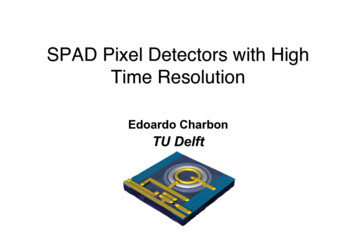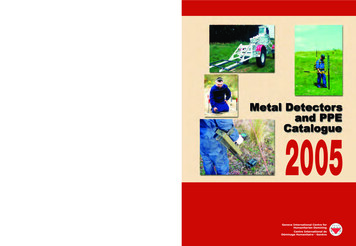
Transcription
SPAD Pixel Detectors with HighTime ResolutionEdoardo CharbonTU Delft
Photons2
Not Only Intensity CountingTime-of-arrivalCorrelation3
Correlating PhotonsPolaritons in GaAsmicrocavity (λ 770nm)Green Hg line from Hg-Ardischarge lamp (λ 546nm)Young’ interference fringesBalili, Science 316, 1007 (2007)Photon statesIncoherentCoherentg(1)(0)01g(2)(0)11Thermal 124
Stellar Hanbury-Brown and TwissInterferometer5
Modern g(2) ImagerCMOS chip4x4 SPAD array10Hz dark count rate120dB dynamic range70ps resolution25% detection prob. On-chip electronics for digital outputsOff-chip processing (e.g. with digital oscilloscope)4x4 array: 120 HBT coincidence experiments running simultaneously6
Time-resolved Bioimaging Super-resolution Microscopy– Stimulated Emission Depletion (STED)– Single Plane Illumination Microscopy (SPIM)– Scanning Photoionization Microscopy (SPIM) Molecular Imaging– Fluorescence Lifetime Imaging Microscopy (FLIM)– Förster Resonant Energy Transfer (FRET)– Fluorescence Correlation Spectroscopy (FCS) Nuclear Medicine– Positron Emission Tomography (PET)– PET & Magnetic Resonance Imaging (MRI)– Single-photon Emission Computer Tomography (SPECT)7
Outline Single-Photon DetectionFrom Pixel to ImagerScaling Up ApplicationsThe Next Big Challenges8
Single-Photon Detection9
Single/few-photon Detectors Charge coupled devices (CCDs)Electron Multiplying CCDs (EMCCDs)Streak CamerasPhotomultiplier Tubes (PMTs)Multi/micro-channel plates (MCPs) Silicon Avalanche Photodiodes (SiAPDs) Single-Photon Avalanche Diodes (SPADs)10
Multiplication in Silicon Review:Photon to electron - Secondary electron - MultiplicationMultiplication in depletion region by impact ionizationp depletionregionReversebiasVn- n 11
Linear (or Proportional) Mode-IAVbdIAnp AvalancheVConventionalVopticalgain G High variability of gainFrom bias1Ve Vbd12V
Geiger Mode (SPAD)-IAVbdIAnp VGeigerAvalancheConventionalVopticalgain G Virtually infinite gain1Ve Vbd13V
Early SPAD Si Integration Reach-through APD (RAPD)– Vertical structure, thick device, high voltagesp πAbsorptionMcIntyre et al.Multiplicationpn Patterned double epitaxial APD (DJ-SPAD)– Planar structure, thin device, rel. low voltagesn Multiplicationp p-epin-substrateCova et al.14
Planar Processes p- guard ring for electric field reduction in edges Prevention of premature edge breakdown Creation of zone with constant electric fieldMultiplication regionp pn-wellp substrateElectric Field ξ15
Quenching the AvalanchePassive quenching:Operation cycle:VVop’Vop’photonarrivalDEAD TIMERqIAVSPADrechargeVVbdavalanchequenchingtDead time16
Controlling Dead TimeVphotonarrivalVop’VDEAD TIMESPADrechargeDead timetVbdavalanchequenching17
Double Threshold Active QuenchingNiclass, Thesis 200818
Salient Specs in SPADs Dead timeAfterpulsingDark countsPhoton detection probability (PDP)Timing resolution and in SPAD imagers Cross-talk PDP Uniformity19
Dark Counts: Dark Count RateMechanisms:–Band-to-band tunneling generation–Trap-assisted thermal generation–Trap/tunneling assisted generation State-of-the-art SPADs in dedicated technology:0.1 1Hz/µm2 State-of-the-art CMOS SPADs:1 10Hz/µm211Hz15x15250Hz50x503kHz20
Band-to-band TunnelingIneffective guard ring:Tunneling due to high dopingEffective guard ring:Low-probability tunneling21
Guard Ring Efficacy Ineffective guard ring Thus, high DCR Uniform multiplication zone Good prevention of prematureedge breakdownNiclass, Charbon, et al., JSTQE’07Gersbach, Charbon, et al., ESSDERC’0822
Dark Count RateNiclass et al. 200623
Photon Detection ProbabilityGersbach, Charbon, et al. SS Sensors 200924
Timing ResolutionPMT: 28psCMOS SPAD: 47ps[Becker & Hickl]25
From Pixel To Imager26
SPAD in CMOSVDDVOP’RQIAVDDdigitalpulseTQOUTVPassive quenching techniqueVOPDIGITAL DOMAIN27
Challenge Photocharges cannot be accumulated like inCCDs Photon pulses arrive when photons impingeHow to capture photon counting?How to capture photon arrivals? in parallel, on thousands ofpixels!28
Imaging: Three Architectures1.2.3.Random Access ReadoutEvent-driven ReadoutFully-parallel Processing29
1. Random Access Readout Pros– Simple Cons–––Highly inefficientLow frame rateEnormous number of photons lost!30
Random Access ReadoutGuard RingAnodeLogic GatesNiclass, Charbon, et al. JSSC 0531
First Massive SPAD Pixel ArrayNiclass, Charbon, ISSCC 0532
Photon Counting Uniformity Uniform counting at low, medium and high illumination33
Spatio-Temporal Uniformity7570FWHM/psTi:Sapphire femtosecond laserλ 470nmTAC resolution 4.88ps8065605550051015202530column number34
Cross-talk Electrical cross-talk reduced by potential barrierOptical cross-talk alleviated by reduced number of carriers in avalancheNiclass, Charbon, et al. JSSC 200535
Ultra-high Dynamic Range4µs10µs25µs100µs1ms36
2. Event-Driven ReadoutSPADSPADSPADCOLUMNSPADIDTDCID Pros– Ideal with low photon counts Cons– First photon of column detected– Large dead time37
LASP ArchitectureNiclass, Favi, Kluter, Gersbach, Charbon, ISSCC2008, JSSC 200838
LASP:First Fully Integrated Sensor32 Event-driven MUXes32 parallel TDCsR 70-500nsTP 97ps128x128 SPAD array6.4Gb/s I/OsNiclass, Favi, Kluter, Gersbach, Charbon, ISSCC 2008, JSSC 200839
TCSPC Test40
3D Imaging: Time-of-flight CamTime-of-flightpulsedlight sourceTOFmeasurement3D imagereconstructiontargetSingle-photonsensordd (c/2) TOF41
Three Dimensional ImagingAccuracy: 1mmFrame rate: 1HzDigital output42
3. Fully Parallel pply/Bias Lines43
Pros and Cons Pros– Full parallelism– No photons are lost within detection cycle Cons– Readout bandwidth– Substrate/supply noise44
MEGAFRAME:Massive Integration in DSMI/O 6 ArrayPrinciple of TDC32x16 ArrayPLL clockSTART O padsImplemented on 130nm CMOS45
Pixel SchematicThermometercoderVdd10b memoryColumndata busCalQuenching16 element delay lineSTARTSPADFF6b ripple counterGlobal STOPFrequency doublerGlobal clock280MHzDelay elementGersbach, Charbon, et al., ESSCIRC 2009Pitch: 50umMax. Resolution: 119psBandwidth: 1MS/sAccuracy: 1.2LSB (INL)Timing jitter: 128ps (FWHM)Timing uniformity: 2LSB46
Pixel LayoutOver 500 transistorsIn 50 x 50 µm247
TDC PerformanceDNLINL48
TDC Uniformity49
Dark Count RateMedian DCR: 100Hz50
Timing Jitter51
The MEGAFRAME32 Chip1.6mmPLLI2C32x32 pixelarray 1MS/s-pixel 100ps resolution 100ns range 1.2LSB precision 2LSB uniformityGersbach, Maruyama, Labonne, Richarson, Walker,Grant, Henderson, Borghetti, Stoppa, and Charbon,ESSCIRC 200952
Scaling Up Applications53
Less than 32 SPADs
Chemiluminescence ReactorGersbach, Maruyama, Sawada, Charbon, µTAS’0655
Chemiluminescence Reactor56
Chemiluminescence Reactor57
Integrated MicroreactorFluidic channelSPAD ArrayECL ReservoirSU8 channel reactorIgG ReservoirIn Situ Optical DetectionE. Charbon and Y. Maruyama,Springer, 201058
32 to 1024 Pixels
Two-photon FLIM SetupMode-lockedTi:SapphireLaser(740 920nm)AttenuatorDichroicBeam SplitterDetectorFilter(λ 488nm)TDCFluorescent sampleOn x/y tableHistogram processing60
Triple-exponential DecayFluorophore:Oregon Green Bapta-1Gersbach, Charbon, et al.,Optics Letters, 200961
Wide-field One-photon FLIMRahmadi Trimananda62
The Sample63Source: West Georgia Microscopic CenterBisaccate Pine Pollen (Magnification: 3200x)
Wide-field One-photon FLIM254msMarek Gersbach64
1024 to 20,000 Pixels
The Megaframe-128 ChipC. Veerappan, J. Richardson, R. Walker, D.-U. Li, M. W. Fishburn, Y. Maruyama,D. Stoppa, F. Borghetti, M. Gersbach, R.K. Henderson, E. Charbon, ISSCC2011
The Megaframe-128 Chip
The Megaframe-128 Chip50um pitch12.3mm11.0mm
Imager Block Diagram
Pixel ArchitectureMatt W. Fishburn
Photon CountingMatt W. Fishburn
Photon Time-of-ArrivalMatt W. Fishburn
TDC CharacterizationINLDNL55ps resolution, 55ns range
System-level Timing UncertaintyBlue laserRed laser
Cumulative Noise
Optical Burst Detection UniformityChockalingam Veerappan
MEGAFRAME Summary Format: 160x128 pixelsTiming resolution: 55psImpulse resp. fun.: 140psDCR (median): 50HzR/O speed: 250kfpsSize: 11.0 x 12.3 mm2
MultisensorChip Pitch: 25µm Single shot time res.:230ps Readout speed:40 2441fps PRNU:3.5%Y. Maruyama and E. Charbon,Transducers,Transducers 201178
Multisensor Principle Analysis– Electrochemical– Optical– CombinationopticalexcitationLabeled and label-lessDNA probesopticalanalysiselectrochemicalanalysis7979
DNA from Blood and UrineYuki Maruyama80
Point-of-care CycleYuki Maruyama81
Single-photon detection inMedical Applications
Positron Emission Tomography(PET)PMTscintillatorCoincidenceγ1mee AnnihilationMost commonly used:Fludeoxyglucose (18F)γ83
Positron Emission Tomography(PET)Source: SunCancerousGanglion84
The SPADnet ProjectObjective:Fully digital, scalable photonic component capableof detecting single and multi‐photon bursts, theirtime‐of‐arrival and intensityDETECTORCOMMUNICATIONDATA BUS85
The Innovation SPAD sensors with massively parallel chip-leveltime detection Large format with through-silicon-via basedpackaging Advanced optical coupling Network between sensors with high-speedmessage-passing Digital coincidence by hierarchical messagesnooping Novel image reconstruction exploiting spatialinformation86
The Impact Cheaper, simpler, scalable, robust PETs Higher levels of reliability Higher speed and flexibility in dataprocessing for imaging Full compatibility with MRI and otherimaging techniques Use of existing and new radiotracers withlow lifetime and high specificity will befeasible87
The Next Big Challenges88
Moore’s Law for Single-photon1M1 Mpixel0.8 CMOS0.35 CMOS512x256100 kpixel128x12810 kpixel160x12864x48130nmCMOS1 kpixel112x490nmCMOS128x232 pixel200320062009201289
Fill FactorGuard rings, design rules, on-pixelprocessing0.8µm CMOS0.35µm CMOS0.13µm CMOS90nm CMOS10µm?25µm59µmFF 1%15µmFF 9%FF 25%FF 35%90
How Far Are We from 1Mpx? Current minimum pitch: 15µm (0.13µm) 1024x1024 pixels: 16x16mm2 Assuming a minimum pitch of 10µm (90nm) 1024x1024 pixels: 11x11mm2Richardson et al., IISW 200915µµm91
Bioimaging Projects 2P FLIM (P. French, Imperial College, London) Fluorescence imaging in 9.4T MRI (with Prof. Rudin,ETH) SPIM*-FCS (with Prof. Langowski, Heidelberg) TIRF DNA probing (with COSMIC, Edinburgh) NIRI (with Dr. Wolf, USZ)92*Selective/Single Plane Illumination Microscopy
Other Medical Projects Intra-operative ß probe (CTI-Forimtech)Concept: wireless, disposable probe– Detect and localize small tumours or metastatic lymph nodes intraoperatively– Guide biopsy probe to tumour– Delineate tumour borders or invasion during operations– Search and localize tumourresiduals at the end of thesurgical interventionTarget: melanoma, pelvic tumours,mediastinoscopy93
Other Medical Projects (Cont.) Intra-operative sensors (EndoTOFPET-US, FP7 project)Concept: asymmetric PET with TOF– External SiPM plate– Endoscopic plate– Ultra-sound guidanceTarget: prostate, pancreasTumourExternal SiPMplate forcoincidenceRectal/intestinal Endoscope withMiniature detector array94
Conclusions Single-photon imagers are here to stayNew and old apps enabledNext challenges– More miniaturization– More parallelization– More flexibility– Novel imaging paradigms95
Acknowledgements96
http://cas.et.tudelft.nl
Logic Gates Guard Ring Anode Niclass, Charbon, et al. JSSC 05. 32 First Massive SPAD Pixel Array Niclass, Charbon, ISSCC 05. 33 . 32x32 pixel array I2C PLL 1.6mm 1MS/s-pixel 100ps resolution 100ns range 1.2LSB precision 2LSB uniformity The MEGAFRAME32 Chip. 53 Scaling Up Applications.




